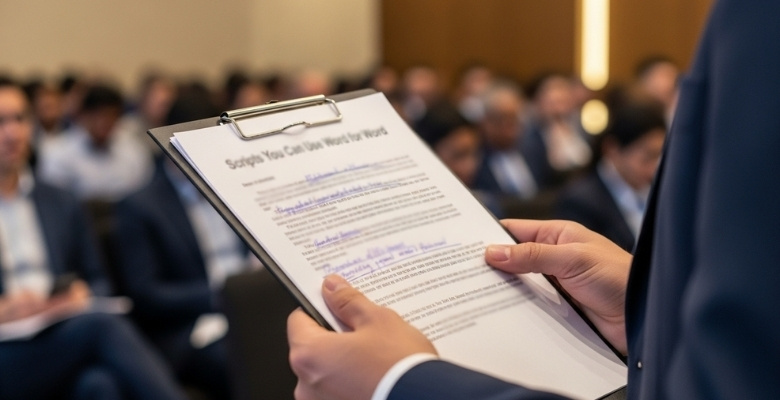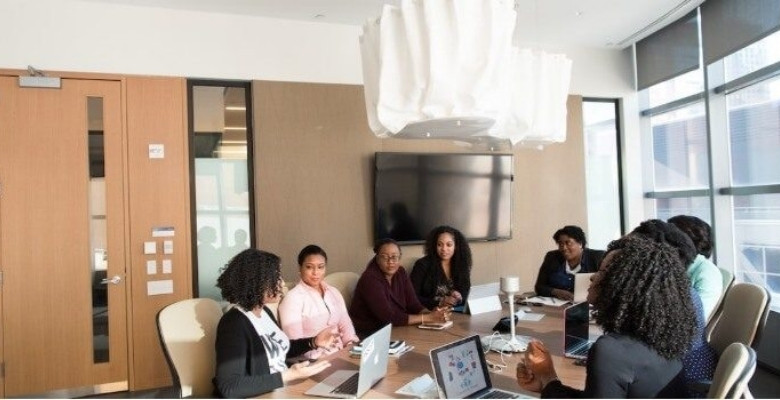Every conference relies on more than great research and eager audiences, it also depends on someone who can keep things running smoothly. That person is the session chair, a role often overlooked but critical for the success of each session. So, what is the role of the session chair in a conference?
Simply put, the chair ensures speakers are introduced properly, talks run on time, and discussions stay respectful and engaging. Their guidance creates a structured, professional environment where both presenters and attendees get the most value. When done well, this role turns the collection of talks into a continuous, meaningful experience.
By balancing time, flow, and inclusivity, the session chair helps maintain order while also making space for learning and collaboration. Understanding this responsibility is the first step to leading sessions with confidence. So, keep reading the full article to see how a session chair’s role shapes the entire conference experience.
What is the Role of a Session Chair in a Conference?
Conferences depend on structure and timing, and the session chair ensures both. Their job goes beyond simple introductions; they set the pace, keep speakers on time, guide discussions, and handle problems gracefully. If you’ve ever wondered about the session chair meaning, it simply comes down to being the person who makes sure every part of the session runs smoothly from start to finish. Here’s a clear breakdown to help you succeed.
Quick Checklist: What a Session Chair Does
- Open the session with a clear welcome and housekeeping notes
- Introduce speakers and keep presentations on time
- Moderate audience questions and discussions
- Handle technical or logistical issues on the spot
- Maintain professionalism, inclusivity, and accessibility
- Summarize key points and close the session smoothly
Opening the Session
The chair begins by welcoming the audience, outlining the agenda, and sharing housekeeping details such as timing or Q&A format. This introduction sets the tone for the session, makes expectations clear, and builds rapport between speakers, attendees, and the overall conference schedule.
Introducing Speakers and Managing Time
Every speaker deserves equal respect and fair timing. A chair introduces each presenter with clarity, highlights their background, and ensures presentations remain within the allotted slot. By keeping strict time, the chair prevents overruns and allows all talks to be heard without rushing.
Moderating Audience Questions
Once presentations are complete, the chair opens the floor for questions. Their role is to guide the discussion, ensure questions are respectful, and keep the exchange on topic. A good chair balances participation so that multiple voices can be heard without the session running late.
Handling Issues and Logistics
Unexpected problems are part of any conference, from microphone failures to speakers arriving late. The chair acts quickly and calmly to resolve these challenges. Their problem-solving skills ensure that disruptions remain minimal, keeping the session professional and attendees engaged.
Ensuring Professionalism and Inclusivity
A session chair represents the conference’s values. That means encouraging respectful dialogue, inviting diverse perspectives, and maintaining accessibility for all attendees. Small gestures, like repeating questions into the microphone or ensuring everyone can hear clearly, demonstrate inclusivity and professionalism.
Closing the Session
The final responsibility of the chair is to wrap up the session neatly. They summarize key insights, thank the speakers and audience, and announce the transition to the next program. A strong closing provides clarity and leaves participants with a sense of completion.
Being a session chair combines hosting, moderating, and leadership skills. By managing time, guiding discussions, solving problems, and wrapping up professionally, you help both speakers and attendees get the most out of the event. These skills will prove especially valuable if you plan to take part in upcoming conferences in Canada or anywhere in the world, where professionalism and structure are key to a successful experience.
Responsibilities at a Glance
A session chair’s role spans three stages: before the session begins, while it is in progress, and after it wraps up. Each stage comes with specific duties that ensure the session runs smoothly and professionally. Here’s a quick overview of these responsibilities at a glance.
| Stage | Task | Owner | Time Budget | Tools or Prompts |
| Before | Check AV setup (projector, mic) | Chair + AV team | 15–20 minutes | Timer, slides, backup cables |
| Confirm speaker order & timing | Chair | 10 minutes | Printed agenda, timecards | |
| Greet speakers & set expectations | Chair | 5 minutes | Intro notes, water, seating | |
| During | Open session & welcome audience | Chair | 2 minutes | Housekeeping script |
| Introduce speakers & manage order | Chair | 1–2 minutes | Speaker bios, cards | |
| Keep presentations on schedule | Chair | Ongoing | Timecards, hand signals | |
| Moderate Q&A fairly and on-topic | Chair | 5–10 minutes | Mic, phrases, question queue | |
| Handle unexpected issues (tech, etc.) | Chair | As needed | Quick scripts, backup plan | |
| After | Summarize key takeaways | Chair | 2 minutes | Closing script |
| Thank speakers & audience | Chair | 1 minute | Notes, acknowledgment cues | |
| Handover to next session | Chair | 1–2 minutes | Clear announcement |
Download the Session Chair Responsibilities Checklist (PDF)
Run of Show Timeline: 60 Minute Session Playbook
Knowing your responsibilities is one thing, but understanding how they fit into the flow of a real session is what makes you an effective chair. A simple timeline helps you stay calm, confident, and ready for anything. Here’s how a typical 60-minute session usually unfolds.
T-30 minutes: Room and AV check
Arrive early to test the microphone, projector, clicker, and lighting. Make sure water is available for speakers, timecards are within reach, and the session agenda is clear. This extra time allows you to fix issues before anyone arrives.
T-10 minutes: Speaker lineup and cues
Meet your speakers, confirm the order of presentations, and remind them of their time limits. Share how you’ll signal “5 minutes left” and “time’s up.” A quick briefing builds trust and prevents confusion once the session begins.
T+0: Welcome and housekeeping
Open with a brief welcome, outline the session format, and share housekeeping notes such as Q&A rules or timing. Keep it short but warm, so the audience knows what to expect and the speakers feel supported.
T+5: Talk 1 begins
Introduce the first speaker clearly and professionally. Then shift your attention to timekeeping. If the speaker starts to run long, prepare to give your pre-agreed signal without breaking their flow.
T+25: Talk 2 begins
Repeat the same process for the second speaker. Ensure smooth transitions between talks by thanking one speaker and immediately introducing the next. This keeps the energy high and the audience engaged.
T+45: Q&A session
Open the floor for questions, remind participants to keep questions concise, and direct them respectfully. Manage the time carefully; if you only have 10 minutes, let attendees know you’ll take 2–3 questions.
T+58: Closing and handoff
Wrap up by summarizing key takeaways, thanking the speakers and audience, and reminding everyone of the next session or break. Close firmly on time to respect both attendees and the following chair.
A clear timeline is the best friend of any session chair. By following this simple 60-minute playbook, you’ll stay organized, maintain a steady pace, and deliver a session that feels professional and rewarding for everyone in the room. The more you attend conferences to actively engage with these roles, the more natural and effective chairing will become.
Scripts You Can Use Word for Word
Even the most experienced session chairs sometimes get stuck on what to say in the moment. That’s why having ready-to-use scripts makes such a difference. These simple, word-for-word examples keep you professional, clear, and calm without sounding robotic. Feel free to adapt them to match your own style.
Housekeeping Script
“Good [morning/afternoon], everyone. Welcome to this session. We’ll be hearing from [number] speakers today, and each presentation will be followed by a brief Q&A. Please silence your phones and hold your questions until the designated discussion time. Let’s get started.”
Speaker Introduction Script
“Our first speaker is [name], [title/affiliation]. Their talk today is titled [presentation title]. Please join me in welcoming [name] to the stage.”
(Tip: Keep introductions short – just name, role, and topic. Save detailed bios for the printed program.)
Time Warnings
At 5 minutes remaining:
“Just a reminder that you have five minutes left.”
At 1 minute remaining:
“Please wrap up your key points — we’ll move to the next speaker shortly.”
(These can be spoken aloud or shown with simple timecards.)
Polite Cutoff Line
“Thank you, [speaker’s name]. To keep us on schedule and give all our speakers equal time, we’ll need to stop here. I encourage anyone with follow-up questions to connect with [speaker] during the break.”
Q&A Moderation Phrases
- Opening: “We now have time for a few questions. Please keep them concise so we can hear from multiple participants.”
- Handling a long question: “That’s a great point — let me summarize to make sure everyone heard it correctly…”
- Moving on: “Thank you for that. Let’s hear from another attendee.”
Tech Failure Message
“It looks like we’re having a small technical issue. Please bear with us for a moment while the team fixes it. In the meantime, [speaker], perhaps you can begin with your introduction while we sort out the slides.”
Accessibility and Inclusion Cues
“Before we start, just a quick reminder to use the microphone when asking questions so everyone can hear. I’ll also repeat each question for clarity. Please keep comments brief so we can include as many voices as possible.”
With a few go-to scripts in your pocket, you’ll never feel caught off guard. These lines make transitions smoother, keep the energy positive, and help you stay in control while still being approachable. Adapt them to your voice, and you’ll sound both natural and professional every time.
Download the Session Chair Cheat Sheet
Smart Tools to Manage Session Timing
One of the biggest challenges for any session chair is keeping everything on schedule without upsetting speakers or cutting off valuable discussions. The good news is that with a simple toolkit, you can stay in control and keep sessions running smoothly. Time management is one of the most important session chair responsibilities, and getting it right ensures fairness for every speaker and clarity for the audience. Let’s break down the essentials you’ll want to rely on.
Talk Lengths
Most conferences stick to standard formats. A research paper might get 15–20 minutes, while a keynote could run 30–45 minutes. Always check the program in advance, then remind speakers of their slot before starting. Keeping these boundaries clear helps prevent awkward overruns.
Visible Timecards Text
Printed cards or small signs with clear text – “10 MIN,” “5 MIN,” “1 MIN,” “STOP”, are simple but effective. Hold them up quietly so the speaker sees them without distraction. This method is more polite and less disruptive than cutting in verbally.
Timer Options
A stopwatch, a smartphone with airplane mode on, or even the built-in timer on the conference AV system can all work. Some chairs prefer phone timers with vibration alerts so they know exactly when to raise a timecard without constantly checking the clock.
Where to Place Timers and Who Watches
Keep your timer where you can see it at a glance, usually on the desk in front of you or beside the microphone. As the chair, you’re responsible for watching the time. Don’t rely on AV staff or assume speakers will self-manage, because most won’t.
Good timekeeping is one of the simplest ways to run a professional session. With the right mix of talk length planning, clear time signals, and a reliable timer, you’ll keep the flow smooth and respectful for everyone. Master this toolkit, and the rest becomes much easier.
How to Handle Tricky Situations: From Issue to Action
Even the best-planned sessions can throw you a curveball. A speaker might run long, the microphone may stop working, or someone in the audience could push the discussion off track. The session chair’s job is to handle these moments calmly and professionally. Here’s a quick table to guide you through common challenges and how to respond.
| Issue | What You See | What You Say | What You Do Next |
| Overrun | Speaker continues past their time | “Thank you, we’ll need to pause here to stay on schedule.” | Politely cut off and move to the next speaker. |
| No-Show Speaker | A scheduled presenter does not arrive | “Our next slot is open. Let’s take a short pause before continuing.” | Adjust the agenda; extend Q&A or move to the next talk early. |
| Hostile Question | Aggressive or argumentative attendee | “Thank you for raising that. Let’s keep our discussion respectful.” | Redirect the discussion to another attendee with a new question. |
| Mic Hogging | One audience member asks multiple long questions | “Let’s hear from someone who hasn’t spoken yet.” | Actively call on a different attendee. |
| AV Failure | Slides, mic, or projector stop working | “We’re having a small technical issue, please bear with us.” | Signal AV staff, invite the speaker to continue verbally in the meantime. |
| Accessibility Request | Attendee asks for a repeated question or clarity | “I’ll repeat questions into the mic so everyone can follow.” | Repeat all questions clearly; adjust as needed. |
| Late Turnover | Previous session ended late | “Thank you for your patience. We’ll begin right away.” | Shorten intros, tighten Q&A, keep to revised timing. |
| Evacuation | Fire alarm or a safety issue occurs | “Please exit calmly through the nearest exit.” | Leave the room with attendees, follow safety instructions. |
Hybrid and Virtual Chairing Basics
Chairing a hybrid or online session means juggling both in-person and remote audiences. It’s easy for one side to feel left out if you don’t plan carefully. A quick checklist like this makes sure everyone stays included and your session runs smoothly.
Hybrid & Virtual Chairing Checklist
- Platform Prep: Test microphones, screen sharing, breakout rooms, and chat before starting. Do a quick run-through with speakers.
- Chat Flow: Assign a helper to watch the chat and flag questions so remote participants feel included.
- Repeat Questions: Always repeat in-room questions for remote attendees, and summarize online questions for in-person audiences.
- Latency Buffer: Pause a few extra seconds when switching between speakers or Q&A to allow for audio/video delay.
- Backup for Dropouts: If a virtual speaker disconnects, move to the next item and return if they rejoin. Keep a backup contact handy.
Using this checklist helps you keep hybrid and virtual sessions smooth, fair, and engaging. When both in-person and remote participants feel equally valued, your role as chair becomes even more impactful.
Inclusive And Accessible Moderation
A good session chair makes sure every voice can be heard and every attendee can follow along, no matter their background or needs. Accessibility isn’t about doing extra work, it’s about small, thoughtful habits that create an inclusive environment for everyone. Here’s a practical checklist to guide you.
Inclusive Moderation Checklist
- Mic Etiquette: Remind all speakers and audience members to use the microphone, even if their voice carries, so remote and hearing-impaired attendees aren’t left out.
- Invite Diverse Voices: Encourage questions from people who haven’t spoken yet, and avoid letting one or two voices dominate the discussion.
- Repeat Questions: Restate audience questions into the mic so everyone, including remote participants, can hear them clearly.
- Describe Visuals: When slides or charts are shown, briefly describe key visuals so attendees with visual impairments can follow along.
- Manage Noise and Aisles: Keep walkways clear and minimize background noise so the session remains comfortable and accessible for all.
Moderation isn’t only about time and flow, it’s about making sure everyone feels included. By following this checklist, you create an environment where discussions are richer, more respectful, and open to every participant.
Working With Speakers Before the Session
A successful session often depends on preparation that happens long before anyone steps up to the podium. As chair, it’s your job to connect with speakers early, set expectations, and make sure they’re comfortable with the schedule. A simple email can do wonders to avoid last-minute chaos. Here’s a template you can adapt and use.
Session Chair Email Template
Subject line: [Conference Name] – Session Details and Speaker Guidelines
Hello [Speaker Name],
I’m delighted to be chairing your session at [Conference Name] on [Date]. To help us run smoothly, here are a few key details:
- Order of presentations: You’ll be speaking [first/second/etc.].
- Timing: Each talk is [X minutes], followed by a [Y-minute] Q&A.
- Slides: Please send your slides by [deadline date] so AV staff can review them.
- AV needs: Let me know if you require sound, video, or special equipment.
- Disclosures: If applicable, please share any required disclosures or acknowledgments in advance.
- Signals: I’ll give a “5 minutes left” signal and a “time’s up” sign to help you stay on schedule.
If you have any questions or concerns, feel free to reach out before the conference. I’m looking forward to your presentation.
Best regards,
[Your Name]
Session Chair, [Conference Name]
Clear communication with speakers before the session saves you stress and sets them up for success. A simple email like this builds trust, avoids confusion, and ensures your session feels smooth and professional from start to finish.
After The Session: Wrap and Follow-ups
Your role as a session chair doesn’t end the moment the last talk finishes. What you do immediately afterward sets the tone for the rest of the conference and reflects on your professionalism. A few simple follow-ups keep everything tidy and leave a strong final impression. Here’s how to handle it step by step.
Closing Thank You Lines
Always end on a warm, professional note. A simple script works best:
“Thank you to our speakers for sharing their insights, and thank you to all attendees for your thoughtful questions. Please join me in giving them one more round of applause before we transition to the next session.”
Summary Email to Organizers
Send a short recap to the organizers within a few hours of your session.
Template:
Subject: Session Summary – [Session Title]
- Number of speakers: [X]
- Number of attendees: [Approximate]
- Main themes discussed: [2–3 bullet points]
- Issues encountered: [Tech glitches, timing, etc.]
- Overall outcome: [Smooth, lively, etc.]
Short Feedback Note to Speakers
A quick personal thank-you goes a long way.
Template:
“Dear [Speaker Name], thank you for your excellent presentation today. The audience clearly valued your insights, and it made the session engaging and worthwhile. It was a pleasure working with you.”
Incident Log Snippet
If anything unusual happened — such as a late speaker, tech issues, or audience disruptions — note it briefly. This helps organizers improve future sessions.
Template:
- Incident: [Describe briefly]
- Time: [When it occurred]
- Action taken: [What you did]
- Outcome: [Resolved/unresolved]
Following up after the session may seem small, but it makes a big difference. Thanking people, sharing a quick summary, and noting issues show professionalism and care. These simple steps ensure your session isn’t just complete, it’s remembered for all the right reasons.
Qualities of an Effective Session Chair
A strong session chair does more than watch the clock. They guide conversations, create a respectful space, and set the right atmosphere. When organizers introduce session chair in conference, these qualities instantly reassure both speakers and attendees.
- Communication Skills: The chair must speak clearly, introduce speakers smoothly, and guide discussions in a way that feels natural. A confident but approachable tone keeps both speakers and the audience engaged.
- Time Discipline: Conferences live and die by timing. A good chair respects the schedule, gives fair minutes to every speaker, and avoids overruns that cut into others’ time or cause delays.
- Diplomacy: Not every question or situation goes smoothly. A chair needs tact to redirect difficult discussions, keep the atmosphere respectful, and ensure no one feels ignored or shut down.
- Subject Familiarity: Knowing the basics of the session’s topic helps the chair introduce speakers properly and ask clarifying questions. This knowledge also builds trust with the audience.
- Problem-solving: From technical hiccups to missing speakers, unexpected issues will come up. A calm, solution-focused chair keeps things moving without making the problem bigger.
- Attention to Detail: Small things like checking if the microphone works or making sure water is available, add up. Careful attention creates a smooth experience for both speakers and attendees.
These qualities are not just nice to have, they’re what make the difference between an average session and one that people remember. Strengthening these skills will prepare you to lead confidently and ensure your session runs without a hitch.
Benefits of Serving as Session Chair
Taking on the role of a session chair may sound like a lot of responsibility, but it comes with real rewards. Beyond simply keeping time and guiding discussions, the position opens doors to recognition, connections, and personal growth. Here are the key benefits you can look forward to.
Visibility
Serving as a chair puts you in front of peers, organizers, and senior professionals. It’s a chance to be seen as a trusted leader and someone who contributes actively to the academic or professional community.
Networking
You interact directly with speakers, attendees, and organizers, which often leads to valuable connections. Many chairs build collaborations or future opportunities simply through the conversations that happen around their sessions.
Leadership Practice
Chairing strengthens skills like decision-making, time discipline, and managing groups, all of which are transferable to professional and academic roles. It’s an accessible way to sharpen your leadership abilities in a real-world setting.
Learning the Latest Work
You get front-row access to fresh research and ideas. Listening closely to talks while managing the flow keeps you tuned into the latest trends and developments in your field.
Being a session chair is more than a duty; it’s a valuable experience that enhances your profile, skills, and connections. If you have the chance to serve, step into it confidently and use it as an opportunity to grow in every direction.
Common Mistakes and Quick Fixes
Even experienced session chairs can slip into habits that disrupt the flow or make a session less effective. The good news is that most mistakes have easy solutions if you know them in advance. Here’s a quick table of common issues and how to handle them.
| Mistake | Quick Fix |
| Allowing speakers to overrun time | Use clear signals like timecards or a polite verbal reminder at 5 minutes and “time’s up.” |
| Weak or overly long introductions | Stick to the name, role, and title of the talk. Save the full bios for the program. |
| Ignoring accessibility needs | Repeat audience questions into the mic, describe visuals briefly, and ensure microphone use. |
| Not managing Q&A effectively | Set clear ground rules: concise questions only, and aim to include multiple voices. |
| Overloading with housekeeping details | Share only the essentials — timing, Q&A format, and reminders — to keep the audience engaged. |
| Poor handling of technical issues | Stay calm, reassure the audience, and either move forward without slides or shift to the next speaker while tech support resolves it. |
| Closing without a summary | Always end with a brief recap, thank the speakers and the audience, and announce the next session clearly. |
By spotting these common mistakes and applying simple fixes, you can run a session that feels polished, respectful, and stress-free. Small adjustments make a big difference in how both speakers and attendees experience the event.
FAQs
Every session chair faces small uncertainties that don’t always get explained in the main guide. These questions often come up once you’re preparing for the role or right before your session begins. Here are clear answers to the most common ones.
Can I Co-chair a Session With Someone Else?
Yes, some conferences allow co-chairs, especially for large or technical sessions. It can ease pressure and split duties between timing and Q&A. Just be sure to coordinate clearly before the event.
How Early Should I Arrive Before My Session?
It’s best to be in the room at least 30 minutes early. This gives time to test equipment, greet speakers, and check the seating. Arriving early reduces stress and avoids last-minute surprises.
What If a Speaker Brings Extra Slides Beyond the Limit?
Extra slides can throw off timing. Politely remind them before the session about the allotted time and suggest focusing only on key points. If needed, gently cut them off during the talk.
How Do I Encourage Audience Questions When No One Speaks Up?
Sometimes audiences need a little push. You can prepare two or three backup questions in advance. Asking the first one often breaks the silence and encourages others to participate.
Should I Introduce Myself to the Audience First?
Yes, a quick self-introduction helps set a friendly tone. Just share your name, role, and why you’re chairing this session. Keep it brief so the spotlight stays on the speakers.
What if a Speaker Has an Accent That’s Hard to Understand?
As chair, you can help by repeating or summarizing key points or questions. This ensures the audience follows along. Always do it respectfully, making the speaker feel supported rather than corrected.
Concluding Lines
Serving as a session chair is more than keeping time; it is about shaping the entire experience of a session. By guiding speakers, helping the audience, and ensuring flow, the chair becomes an important link in a conference’s success.
The question of What is the Role of the Session Chair in a Conference can be answered simply: it’s about responsibility, respect, and professionalism. A good chair balances fairness with discipline, ensuring every speaker and participant benefits from the session.
By embracing this role with confidence, you gain skills, build visibility, and contribute meaningfully to the event. When done well, chairing a session doesn’t just improve the conference; it strengthens your own growth and professional presence.











